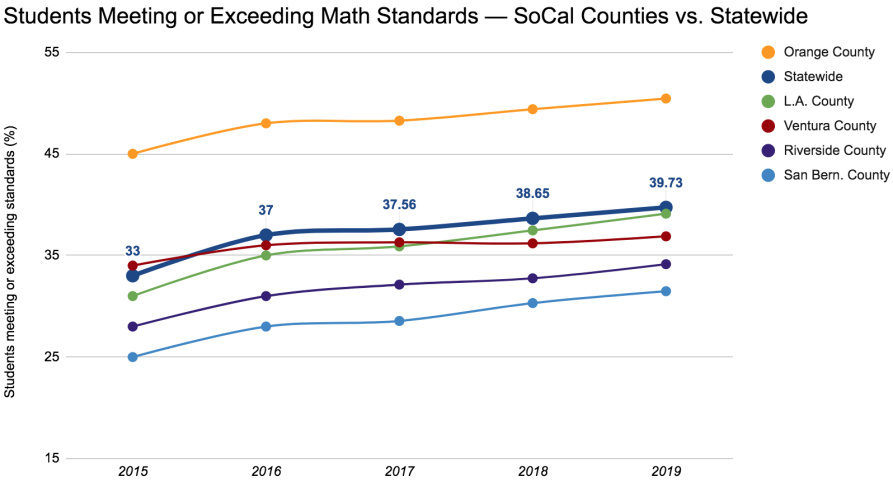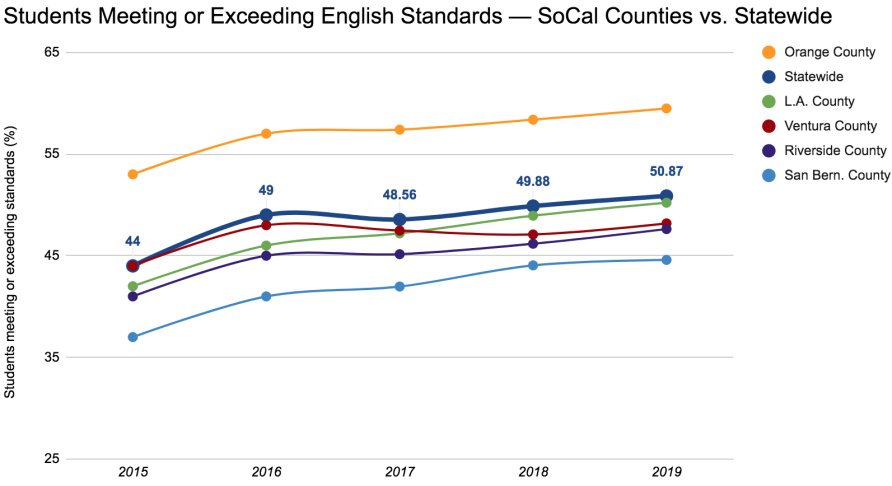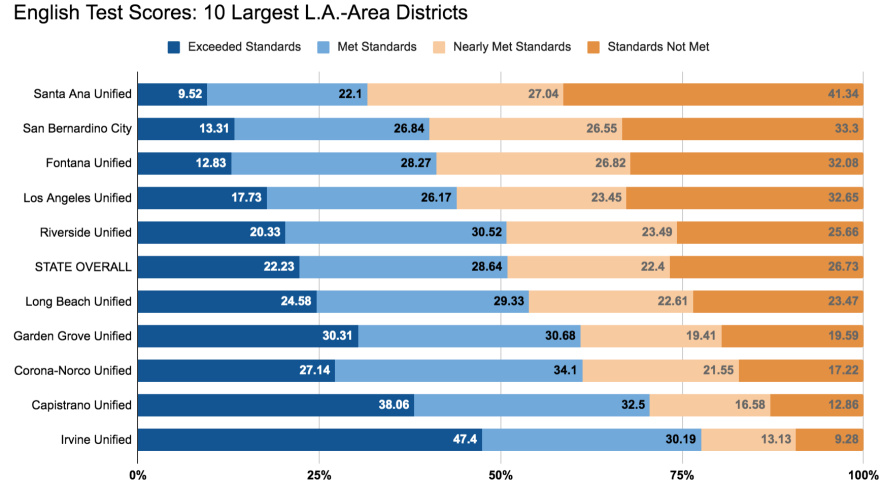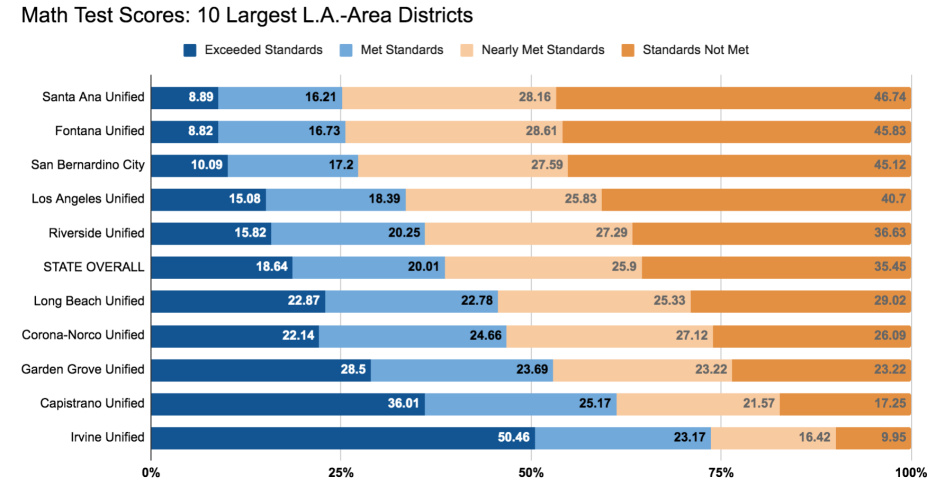SoCal Schools Just Got Their State Test Results Back. Here's How To Find Out How Your School Did
SoCal Schools Just Got Their State Test Results Back. Here's How To Find Out How Your School Did
BY KYLE STOKES IN NEWS ON OCTOBER 9, 2019 2:53 PM


Students at El Sereno Middle School in the Los Angeles Unified School District work on devices. (Photo by Chava Sanchez/LAist)
California education officials released results from the latest round of statewide standardized test scores Wednesday.
The results? A little better than last year — with an emphasis on the word "little."
More students met or exceeded standards on the benchmark English and math exams in 2019 than the year before, the results showed. But state officials acknowledged the modest, across-the-board improvements masked the fact that certain vulnerable groups of kids were not making as much progress.
Achievement gaps highlighted by the exam also remained stark. The state’s black students (33% proficiency in reading and 20.55% in math) and Latino students (40.56% passing in reading and 28% in math) far underperformed their white and Asian peers. More than 65% of California’s white students passed the Smarter Balanced reading portion, and 54.23% passed math, while nearly 77% of Asian students were proficient in language arts and 74.37% passed math.


"Disparities between students of color and their white and Asian peers continue from year to year, and demonstrate the importance of our priority initiative of closing the achievement gap," read a statement from state schools superintendent Tony Thurmond.
Over the five years in which California students have taken the Smarter Balanced exam, statewide reading scores have improved nearly 7 percentage points, from 44% proficiency in 2015 to 50.87% in 2019. Statewide math scores have gone up at a near-identical rate, from 33% proficiency in 2015 to 39.73% in 2019.
Overall, 39.7% of students tested at or above grade level in mathematics — an increase of about a percentage point from last year.

(Kyle Stokes/LAist made with Google Charts)
The increase means that, out of 3.1 million children tested in Grades 3-8 and 11, a few thousand more kids were able to clear the bar this year compared to last year.
"These scores show we were crawling forward when we need to be sprinting," said Elisha Smith-Arrillaga, executive director of The Education Trust-West, an advocacy organization focused on narrowing achievement gaps between privileged and underprivileged students.
- Want to find out how your school performed? Type in your school's name on the state's results website.

(Kyle Stokes/LAist made with Google Charts)
But the results still show that California's black and Latino students are not meeting state standards at nearly the rates their white and Asian peers are — and the gaps between these groups' test scores have narrowed by only a few percentage points since 2015.
WHERE THE LATINO TEST SCORE GAP STANDS NOW:

(Dana Amihere/LAist)
"At the rate we're going, my five-year-old-son will be old enough to be a grandparent before California achieves educational justice for low-income students and underrepresented students of color. That's simply not good enough. We have to do much better, much faster," wrote Ed Trust West's Smith Arrillaga in a statement about the new test results.
WHERE THE BLACK TEST SCORE GAP STANDS NOW:

(Dana Amihere/LAist)
Standardized test results have to be taken with a grain of salt. They're only meant to measure whether students are meeting standards in core subjects, but say little about how schools are faring in pursuit of other bottom-line goals, like helping students to graduate high school or pushing English learners to proficiency.
Many critics, in fact, charge that the most reliable condition test scores measure is how poor a school's students are. Barely one-quarter of students the state considered "economically disadvantaged" met math standards this year, compared to nearly three-fifths of students who are "not economically disadvantaged."
- Want to measure the test score gaps in your school or district? Find your school on the state's results website and select a "Student Group" from the dropdown menus. You can also find a statewide breakdown of the gaps here
"Education equity should mean equity for all students and right now, we are not there," Thurmond wrote in his statement. "All students should have an equal opportunity to succeed academically."
There may be signs of progress at a more granular level. In a statement released today (Weds), California Department of Education officials said performance gaps have narrowed in certain cohorts and between English learners and "English only" students.
HOW LOCAL SCHOOLS FARED
Most scores in the 10 largest school districts in the L.A. metro area either held steady or increased by a few percentage points.

(Kyle Stokes/LAist made with Google Charts)
Long Beach Unified posted the biggest increases of any of these local districts. The rate at which Long Beach students met or exceeded standards increased by 2.7 percentage points in English and nearly 3 points in Math.
In neighboring Los Angeles Unified, scores increased by 1.5 percentage points in English and almost 2 percentage points in math — though LAUSD's marks in both subjects still lag the state overall.
- Want to find out if your district's scores changed? Type in your district's name on the state's results website.

(Kyle Stokes/LAist made with Google Charts)
Two of these ten districts saw scores decrease slightly in one subject area:
Corona-Norco Unified — the state's eighth-largest district — saw its English scores slip by about a tenth of a percentage point, though its math scores increased.
Irvine Unified's math scores were down by half-a-percentage point — though three-quarters of its students are still meeting and exceeding state standards in the subject, well above the state average. Irvine Unified's English scores held steady.



 I haven't taken not one tutoring program
I haven't taken not one tutoring program
